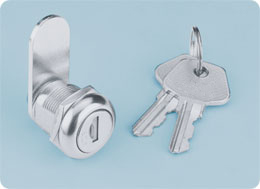
There are different ways to secure cabinets, lockers and other enclosures. You can use a padlock, for instance, or you can use a cam lock. Cam locks are oftentimes preferred over padlocks because they are concealed. You can install a cam lock inside of the enclosure so that it doesn’t protrude out the front. What are cam locks exactly, and how do they work?
What Are Cam Locks?
Cam locks are L-shaped locking mechanisms that are used to secure cabinets, lockers and other enclosures. They consist of two main parts: a cylindrical keyed nut and a tongue bar (also known as a cam). Once installed, you can lock the enclosure by inserting a key into the former part and turning it.
How Cam Locks Work
While there are different types of cam locks, they all work in a similar way. Cam locks are installed directly inside the front of an enclosure. The front of the cam lock will remain flush with the front of the enclosure in which it’s installed.
Locking and unlocking cam locks requires the use of a key. Upon placing a key inside of a cam lock and turning it, the orientation of the tongue bar will change. Turning the key will cause the tongue bar to drop to the side, or it will cause the tongue bar to rise vertically. When dropped to the side, the tongue bar will lock the enclosure. When the tongue bar is vertical, on the other hand, the enclosure will be unlocked.
Choosing Cam Locks: What You Should Know
When choosing cam locks, you should consider the material. Different cam locks are made of different materials. Zinc alloy is a popular material in which cam locks are made. The term “zinc alloy” refers to any metallic material that consists of zinc and at least one other metal. Brass, for example, is a zinc alloy — and it’s commonly used in the construction of cam locks.
If you’re planning to buy multiple cam locks, you may want to get them keyed alike. Keyed alike means that the same key will work for all the cam locks. Whether you order a half-dozen cam locks or 100 cam locks, you won’t have to keep up with multiple keys. You can use the same key to lock and unlock all of the cam locks.
While most cam locks require the use of a key, others don’t. Known as keyless thumb-turn cam locks, they are designed to prevent the front of cabinets and enclosures from opening. They won’t protect against theft. Nonetheless, some people prefer keyless thumb-turn cam locks due to their ease of use.
